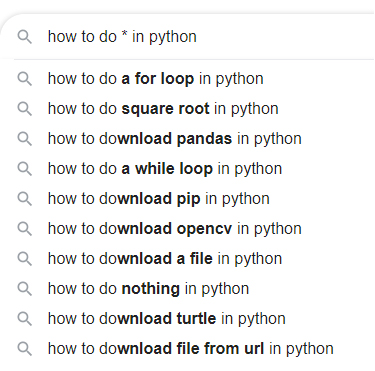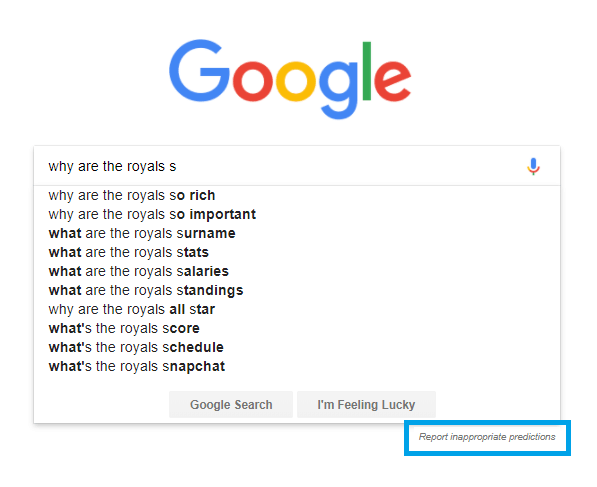Google Autocomplete is a controversial but powerful search feature.
When you type a word, or even a letter, into Google, it populates a list of search suggestions. That’s what autocomplete is.
SEO professionals, paid search marketers, content marketers, and social media managers can all benefit from using Google Autocomplete to help with different keyword-focused and intent-exploring projects.
On the other hand, Google Autocomplete often makes the news for funny, peculiar, or even offensive habits (often in a negative way).
People use autocomplete constantly, saving thousands of seconds per day, but it has also been blamed for political cover-ups and spoiling movies, TV shows, and video games.
Google Autocomplete can also be a powerful marketing tool. SEO professionals and other digital marketers have used it for years to inform strategy, get keywords, and find the important questions customers are asking.
They can use Autocomplete to better optimize clients’ digital properties and the content and messaging that make them up.
This guide will help you understand the real power this simple but super-helpful feature can do for help with your day-to-day tasks.
What Is Google Autocomplete?
Google’s own words, Google Autocomplete is “designed to make it faster to complete searches that you’re beginning to type.”
It’s integrated across Google Search and other Alphabet properties that use Google, including in the “Omnibox” on Chrome.
Google estimates that, cumulatively, it saves over 200 years of typing every day, and on average reduces typing overall by about 25 percent.
The primary purpose of the Autocomplete dropdown is to cut back on time a user spends typing by offering predictions of what a user may be typing — including for websites using the built-in Google Custom Search Engine feature.
While Autocomplete has been a desktop search feature since late 2004, it has become even more useful as a time-saving feature on mobile devices.
Typing on a mobile device is a bit tougher than doing so on the large keyboards we have grown up with and are accustomed to, so it’s a welcomed tool for providing assistance and saving time for many.
There are several other useful ways that the feature can be used to leverage content ideas, keyword suggestions, intent exploration, online reputation management, and other data-driven tasks.
How Does Autocomplete Work?
Ex-Googler Kevin Gibbs created the project, originally called “Google Suggest” by another former Googler Marissa Mayer.
Google has since moved away from the “Suggest” name since it’s not always offering the most thoughtful, caring, or appropriate predictions.
Google calls the completions it offers “predictions”, not “suggestions.” This is because of how Autocomplete works.
Autocomplete is supposed to help people complete a sentence they were intending – not to suggest a search intent, as with “I’m feeling lucky.” They determine predictions by looking at common searches on Google, including looking at trending searches that might be relevant.
This allows Autocomplete to quickly update and adapt to new search trends and news stories.
Much of Autocomplete’s behavior is computer-generated, with data collected from millions of other Google searches and their results, including the content on those pages. It also takes information from your search history, location, and other data points.
Google has also put a lot of work in, so as to avoid inappropriate or offensive autocomplete suggestions. This means there are both automated and manual removal procedures that can influence what autocomplete suggestions are left.
Autocomplete is also related to the Knowledge Graph, and especially on mobile, it can bring Knowledge Graph suggestions into the prediction.
It wasn’t until 2008 that Google built Autocomplete into its default search engine (it was previously an opt-in feature).
Best Ways to Use Google Autocomplete
1. Keyword Research
It’s a long, tedious, and laborious task, but it’s also the foundation of all SEO strategies– and has been for a long time.
While we may no longer explicitly target keywords, keywords and their related ideas are always going to be an important part of search marketing.
Keyword research is one of the first tasks tackled at the start of an engagement — and carried on throughout the engagement — to understand not just a brand and the content it creates, but also its potential shortcomings, website strengths and weaknesses, and content gaps.
Autocomplete doesn’t do all the work for you in terms of keyword research, but it’s a great place to start at or to use early and often when developing content calendars and general organic search strategies.
Using it (along with other keyword resource tools like Google Keyword Planner and other third-party keyword databases) to get an idea of the right keywords you want to target by considering monthly search frequency, competition, and even cost-per-click (CPC) pricing will do your search strategy justice.
One of the shining advantages of Google Autocomplete is its ability to uncover quality long-tail phrases that are commonly searched across the web.
Since the primary measure for Autocomplete is popularity — based on real searches by users in real-time — the value of Autocomplete lies in its plethora of keyword-level data that you can dig up if you work at it hard and long enough.
As always, be sure you are signed out of Google to ensure you limit personalization for an unbiased look at predictions.
Long-tail keywords are incredibly useful when fulfilling content gaps but also offer endless possibilities in terms of high-value blog posts and educational content within a brand’s niche.
2. Intent Exploration
Understanding user intent is important because it guides the goal of the page, its messaging, its layout, and even imagery. We know pages perform best when they fully satisfy the user intent of a search query.
You can use Autocomplete to better understand user intent, but doing so can be involved and laborious. Taking the time to visit many different web pages in the search results tied to specific predictions is going to take some time, focus, and content consumption. But the information you can mine from this method is invaluable.
Keywords overlap various stages of user intent, and without more keyword context, it can be tough to understand the intent.
Autocomplete will help you not just understand different high-value long-tail keywords and the intent surrounding them, but it will also help marketers recognize the volume of content around specific stages of intent, as well as which long-tail phrases and intent stages could be optimized for as a higher priority.
Of course, for high-value keywords — long-tail or traditional one-, two-, and three-word phrases — it’s important to satisfy all stages of intent as they relate to the high-value keywords.
That’s the idea behind an all-encompassing, quality search strategy. And Autocomplete can help get you there.
3. Online Reputation Management
Autocomplete has been significant in the realm of online reputation management, too.
Remember, when a user searches for your name or your brand name, the first thing they see, even before your site on the SERP (search engine results page), is the Autocomplete predictions tied to that name.
If those predictions are negative, or if even just one of them is negative, it can have a real impact on your business’s performance.
Think about it. You search [Dog Washers Inc] and the first prediction finishes with “loses dog,” you probably won’t feel too keen on bringing your dog there for his next bath.
Same for a restaurant; if you search [Ted’s Seaford Spot] and the prediction finishes with “e. Coli,” I have a pretty good idea of what you’re not eating tonight.
Autocomplete makes up an important part of online reputation management (ORM) and cannot be ignored when working to balance all negative connections made with brands.
One must be vigilant, just like most ORM strategies. Several ways brands can work to offset negative Autocomplete predictions are:
- Take control of your brand’s conversations to ensure the right connections are being made in Google Autocomplete.
- Social media account optimization reinforces the positive connections that may be overshadowed by negative ones.
- Social media content, messaging, and engagement are in line with the optimizations above and the brand’s voice and tone.
- Consistent branding and messaging for profile websites with positive keywords association used elsewhere
- Starting small and making an impact by searching for positive connections for the brand from different locations. Obviously, the more people, the better. But you’d be surprised at the impact it can have.
- Building backlinks to Google SERPs for positive keyword associations with your name; things like [sam hollingsworth seo writer] and [sam hollingsworth handicapper] would be great starts for someone like myself. ?
- If there are negative autocomplete suggestions, ensure that you have a strategy of how to address them.
4. Content Generation and Exploration
You can also now use Autocomplete for content generation and exploring competitor content for your own content ideas. It’s easy, and interesting, to use Autocomplete alongside other online writing tools, to find out what web users are searching for.
FAQs
Just looking at “who”, “what”, “where”, “when”, and “why” with a few brand-related questions can get you a ton of questions for your FAQ– questions people may already be searching for.
Related keywords
You can do this in many ways, for many reasons. An easy one is “brand name vs.”– Google will autofill with competitors. You can also look at “brand name and” and see what autocomplete finds there– finding ways to expand your brand.
Related topics
If you can find Autocomplete suggestions for related topics, that aren’t covered by your main topic, you might have an edge to grow some content in that niche.
Queries like “how * works” can be invaluable, autocomplete filling in the wildcard space with suggestions. You can also do this to find questions about your brand, questions for content marketing, find problems potential customers are looking for, and even find out if users are looking for certain social media accounts.
 Screenshot of Google Search, November 2021
Screenshot of Google Search, November 2021Autocomplete Policies
With a history of backlash due to some of its search predictions, Google does manually work to prevent inappropriate Autocomplete predictions when it comes to:
- Sexually explicit predictions.
- Hateful predictions against groups and individuals.
- Violent predictions.
- Danger and harmful activities in predictions.
It also may remove predictions that could be considered spam, facilitate or advocate piracy, or if given a legal request to do so.
Google makes it clear that it removes predictions that relate to any of the above-mentioned situations unless they contain medical or scientific terms that are not malicious.
Looking for Feedback
To better control inappropriate Autocomplete predictions, Google launched its feedback tool and uses the data to make improvements consistently.
For instance, there doesn’t have to be a particular demographic that is being targeted by something hateful in nature; and feedback helps get that discovered faster and easier.
 Screenshot of Google Search, November 2021
Screenshot of Google Search, November 2021Understanding what people are actually searching for is an essential part of your SEO strategy.
See how you can incorporate Google Autocomplete into your research process. You just might be surprised at the specific keywords and search intent it reveals!
More SEO Resources:
Featured image: Shutterstock/Fonstra
Source link



